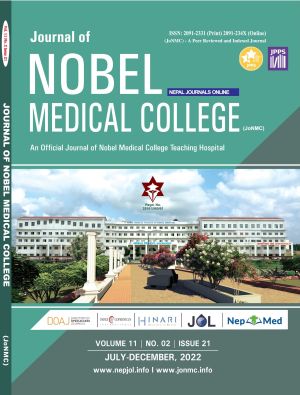Snakebite Incidence, General Awareness and Belief of Snakebite Management at a Rural Municipality of Eastern Nepal
DOI:
https://doi.org/10.3126/jonmc.v11i2.50802Keywords:
First aid, Nepal, Rural Communities, SnakebiteAbstract
Background: Understanding people’s awareness on snakebite management would be highly beneficial to develop strategic program at local levels of Nepal. We aimed to identity snakebite incidence, general awareness and beliefs of people regarding snakebite management in rural communities.
Materials and Methods: A community-based cross-sectional study was conducted at Budhiganga Rural Municipality from September to November 2022 among 245 households. Ethical clearance was taken from institutional review committee of Birat Medical College. Microsoft Excel 2019 and SPSS software ver. 2025 were used for data analysis.
Results: Annual snakebite incidence rate was 2332 per 100000 populations. Majority (71%) could not identify biting snake and attended traditional healers (70%). Among study participants, 25% had false belief that banded krait is not poisonous. Various false beliefs on snakebite first aid management were reported such as use of tourniquet (81%), washing bite sites (53.47%), cutting bite site (52%) and so on. Further, prevalent false beliefs on food-related practices were snake drinks milk (85.31%), giving victim water following the snakebite was beneficial (47%), giving chilly to those bitten was beneficial (41.63%) and so on.
Conclusion: Despite the existing burden of snakebites, people are not aware about the correct ways to manage them and were still attending traditional healers as a means of treatment. The mis beliefs about snakebite first aid management are very much prevalent.
Downloads
Downloads
Published
How to Cite
Issue
Section
License

This work is licensed under a Creative Commons Attribution 4.0 International License.
JoNMC applies the Creative Commons Attribution (CC BY) license to works we publish. Under this license, authors retain ownership of the copyright for their content, but they allow anyone to download, reuse, reprint, modify, distribute and/or copy the content as long as the original authors and source are cited.




